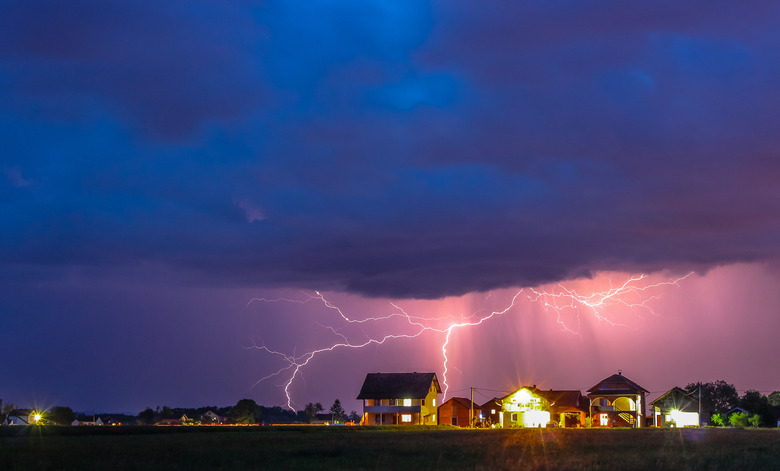Different Kinds Of Weather Conditions
Simply put, weather is the state of the atmosphere in any particular place. Factors such as air pressure and humidity can cause results ranging from precipitation to high winds. While some weather conditions can lead to situations that become "natural disasters," not all natural disasters are weather-related. Earthquakes, for example, have to do with tectonic movement and not the state of the atmosphere. From simple rain to massive hurricanes, weather can take on many different forms.
TL;DR (Too Long; Didn't Read)
Weather takes on many forms, some of which can be deadly. Precipitation, snow and hail occur when water vapor in clouds condenses and falls at varying temperatures. Thunderstorms occur when heat from the ground rises into cooler air, creating an unstable cloud, which may produce precipitation, lightning and thunder. The exact causes of tornadoes are unknown, but these dangerous columns of rotating air form from volatile storms called supercells.
Causes of Precipitation
Precipitation occurs when any form of water falls from the sky. Precipitation includes things like rain, snow, hail and sleet. All of them are forms of water and begin as water vapor in clouds. This water vapor stays in place by updrafts of air, but when water vapor in clouds begins to condense, the droplets become too heavy to stay up. Thus, water falls from the clouds.
If the temperature is low enough for the water to remain liquid, then the precipitation that occurs is rain. However, if the temperature is below freezing, the droplets of water may freeze into flakes of snow or tight balls of ice or hail. If the temperature is above freezing at one level and below freezing at another, then the water may be partly solid and partly liquid by the time it reaches the ground. This kind of precipitation may be sleet or freezing rain.
Causes of Thunderstorms
Thunderstorms occur when rain combines with thunder. Visible lightning may also occur during thunderstorms along with hail or high winds. These storms form when heat in the lower atmosphere pushes large amounts of warm air and moisture into the cooler, upper atmosphere. The warm air condenses and forms an unstable cloud. When precipitation falls from this cloud, it creates a downdraft of air, which spreads out along the ground as gusty winds.
Lightning forms when ice particles in the storm cloud collide with one another and produce electric charge in large quantities. The sound of thunder is an after-effect of this lightning. When lightning strikes, the atmosphere rapidly expands around the electricity, which can cause low rumbling thunder, and then crashes back together again causing loud cracks of thunder.
Causes of Tornadoes
Tornadoes, like lightning and thunder, result from thunderstorms. These rapidly rotating columns of air, which extend to the ground from the base of thunderstorms, are powerful forces of nature. Tornadoes can tear buildings apart and rip trees from the ground, among other feats. Meteorologists aren't completely certain how tornadoes form. They're more likely to form from rapidly rotating thunderstorms, known as supercells. The visible column extending from the bottom of such a storm is a funnel cloud. Only when a funnel cloud touches the ground does it become a tornado.
Even though the exact atmospheric causes of tornadoes are unknown, there are many warning signs that can help identify when a thunderstorm is likely to produce a tornado. When clouds in a thunderstorm get lower at the same time, they may form a visible cloud wall. Cloud walls make the presence of funnel clouds and tornadoes more likely. Low cumulus clouds extending from the southeast or south of a large storm are inflow bands. They can signal that the storm is gathering air from miles away, adding to the risk of rotation and thus tornadoes.
Cite This Article
MLA
Cook, Maria. "Different Kinds Of Weather Conditions" sciencing.com, https://www.sciencing.com/different-kinds-weather-conditions-5090734/. 17 April 2018.
APA
Cook, Maria. (2018, April 17). Different Kinds Of Weather Conditions. sciencing.com. Retrieved from https://www.sciencing.com/different-kinds-weather-conditions-5090734/
Chicago
Cook, Maria. Different Kinds Of Weather Conditions last modified March 24, 2022. https://www.sciencing.com/different-kinds-weather-conditions-5090734/
